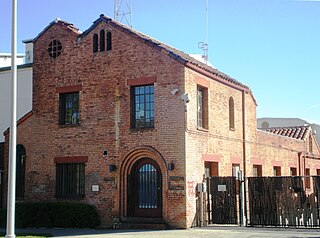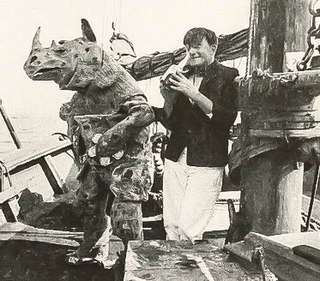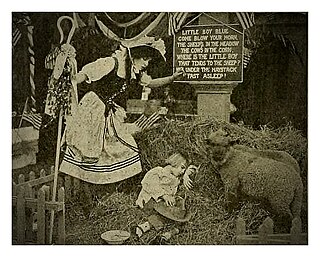
The Motion Picture Patents Company, founded in December 1908 and effectively terminated in 1915 after it lost a federal antitrust suit, was a trust of all the major US film companies and local foreign-branches, the leading film distributor and the biggest supplier of raw film stock, Eastman Kodak. The MPPC ended the domination of foreign films on US screens, standardized the manner in which films were distributed and exhibited within the US, and improved the quality of US motion pictures by internal competition. It also discouraged its members' entry into feature film production, and the use of outside financing, both to its members' eventual detriment.

William Nicholas Selig was a vaudeville performer and pioneer of the American motion picture industry. His stage billing as Colonel Selig would be used for the rest of his career, even as he moved into film production.

The Selig Polyscope Company was an American motion picture company that was founded in 1896 by William Selig in Chicago, Illinois. The company produced hundreds of early, widely distributed commercial moving pictures, including the first films starring Tom Mix, Harold Lloyd, Colleen Moore, and Roscoe "Fatty" Arbuckle. Selig Polyscope also established Southern California's first permanent movie studio, in the historic Edendale district of Los Angeles.

Edison Studios was an American film production organization, owned by companies controlled by inventor and entrepreneur, Thomas Edison. The studio made close to 1,200 films, as part of the Edison Manufacturing Company (1894–1911) and then Thomas A. Edison, Inc. (1911–1918), until the studio's closing in 1918. Of that number, 54 were feature length, and the remainder were shorts. All of the company's films have fallen into the public domain because they were released before 1928.

Siegmund Lubin was an American motion picture pioneer who founded the Lubin Manufacturing Company (1902–1917) of Philadelphia.

Romaine Fielding was an American actor, screenwriter, and silent film director known for his dramatic westerns. He was also known as Royal A. Blandin.

The Kalem Company was an early American film studio founded in New York City in 1907. It was one of the first companies to make films abroad and to set up winter production facilities, first in Florida and then in California. Kalem was sold to Vitagraph Studios in 1917.

Josephine M. Workman better known by her stage name, Princess Mona Darkfeather was an American actress who starred in Native American and Western dramas. During the silent era of motion pictures, from 1911 to 1917, she appeared in 102 movies. She is best known for her role as Prairie Flower in The Vanishing Tribe (1914).

Betzwood is the name of an area of West Norriton Township in Montgomery County, Pennsylvania. The area once housed the Lubin Studios, an early motion picture studio that operated here from 1912 to 1923.

Outwitting Dad is a lost 1914 American silent comedy film produced by the Lubin Manufacturing Company and featuring Billy Bowers, Raymond McKee, and Oliver Hardy in his first known screen appearance.
The Rise of the Johnsons is a lost 1914 American silent comedy film produced by the Lubin Manufacturing Company, featuring John Edwards, Mattie Edwards, and Oliver Hardy.

He Wanted Work is a lost 1914 American silent comedy film produced by the Lubin Manufacturing Company, featuring John Edwards, Mattie Edwards, Billy Bowers, and Oliver Hardy.

The KCET Studios, located at 4401 Sunset Boulevard in Hollywood, California is the longest continuously-producing studio in Hollywood. Since its establishment in 1912, the studios located at the site have been the home of motion picture producers, including Lubin, Essanay, Willis and Inglis, J.D. Hampton, Charles Ray, Ralph Like, Monogram Pictures, Allied Artists, and ColorVision. Since 1970, it has been the home of public television station KCET, but in April 2011, KCET announced that it had sold the facility to the Church of Scientology.
The Bold Bank Robbery is a 1904 short crime film produced and distributed by the Lubin Manufacturing Company. The silent film depicts a group of burglars who plan and execute a successful bank heist. Company employee Jack Frawley was the film's director, also coming up with the story and serving as cinematographer; the cast's identities are unknown. The silent film was the first Lubin Manufacturing Company release to feature an original narrative.

Kansas Saloon Smashers is a 1901 comedy short film produced and distributed by Edison Studios. Directed by Edwin S. Porter, it is a satire of American activist Carrie Nation. The film portrays Nation and her followers entering and destroying a saloon. After the bartender retaliates by spraying Nation with water, policemen order them out; the identities of the actors are not known. Inspiration for the film was provided by an editorial cartoon which appeared in the New York Evening Journal.

The Valley of Lost Hope is a lost 1915 American silent Western drama film directed by and starring Romaine Fielding. Produced by Lubin Manufacturing Company and written by Shannon Fife, the film portrayed the rise and destruction of a gold-mining "boomtown" created by a phony real-estate business. Other cast members included Peter Lang, Mildred Gregory, and B. K. Roberts in principal roles. The production was filmed on location in Philipsburg in central Pennsylvania and at Lubin's backlot and studio facilities in Betzwood, located approximately 20 miles northwest of Philadelphia.

The Ringtailed Rhinoceros is a lost 1915 American silent comedy-drama film that depicted the ruinous effects of alcohol on a good-natured man and on the lives of the people around him. Like snakes and "pink elephants" that have been used in many societies to symbolize heavy drinking or been associated with the hallucinations of drunkards, the main character in this "'photophantasy'" blamed instead a "Ringtailed Rhinoceros" for his excessive use of wine and liquor.

Richard Morris (1862–1924) was an American opera singer, stage performer, and silent film actor. Morris was born on January 30, 1862, in Charlestown, Massachusetts. He was 62 when he died in Los Angeles, California on October 11, 1924. Between 1912 and 1924, Richard Morris acted in 59 films.

On the morning of June 13, 1914, a disastrous fire and a series of related explosions occurred in the main film vault of the Lubin Manufacturing Company in Philadelphia, Pennsylvania. Several possible causes for the blaze were cited at the time, one being "spontaneous combustion" of highly flammable nitrate film, which was the motion picture industry's standard medium for cameras throughout the silent era and for the first two decades of "talking pictures". Millions of feet of film were consumed in the flames, including most of the master negatives and initial prints of Lubin's pre-1914 catalog, several of the company's recently completed theatrical prints ready for release and distribution, a considerable number of films produced by other studios, inventories of raw and stock footage, hundreds of reels documenting historic events that occurred between 1897 and early 1914, as well as other films related to notable political and military figures, innovations in medical science, and professional athletic contests from that period. While this fire was not a decisive factor in Lubin's decline and bankruptcy by September 1916, costs associated with the disaster only added to the corporation's mounting debts, which led to the closure or sale of its remaining operations the following year.

Little Boy Blue is a 1912 silent one-reel film produced by Lubin Manufacturing Company and distributed by the General Film Company. The movie was released on May 6, 1912. The movie featured child actor Raymond Hackett assuming the role of Harold and Marie Wierman playing Elizabeth, Harold's older sister.




















